

SPRING QUARTER, 2006
Department of History
University of California, Irvine
Instructor: Dr. Barbara J. Becker
|
Week 1. Soul excerpts from
|
14. A Bird made to whistle by flowing Water.
Vessels may be made such that, when water is poured into them, the note of the black-cap, or a whistling sound, is produced. The following is their construction. Let ABCD (fig. 14) be a hollow air-tight pedestal: through the top, AD, let a funnel, EF, be introduced and soldered into the surface, its tube approaching so near to the bottom as only to leave a passage for the water.
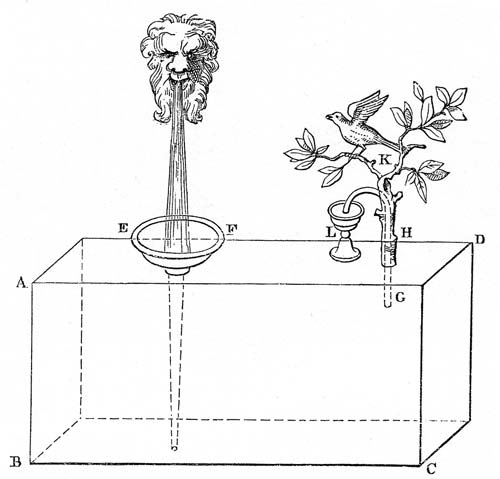
Let GHK be a small pipe, such as will emit sound, communicating with the pedestal and likewise soldered into AD. Its extremity, which is curved, must dip into water contained in a small vessel placed near at L. If water be poured in through the funnel EF, the result will be that the air, being driven out, passes through the pipe GHK, and emits a sound. When the extremity of the pipe dips into water a bubbling sound is heard, and the note of the black-cap is produced: if no water is near, there will be a whistling only.
These sounds are produced through pipes; but the quality of the sounds will vary as the pipes are more or less fine, or longer, or shorter; and as a larger or smaller portion of the pipe is immersed in the water: so that by this means the distinct notes of many birds can be produced. The figures of several different birds are arranged near a fountain, or in a cave, or in any place where there is running water: near them sits an owl, which, apparently of her own accord, turns at one time towards the birds, and then again away from them; and when the owl looks away the birds sing, when she looks at them they are mute: and this may be repeated frequently.
15. Birds made to sing, and be silent alternately by flowing Water.
The construction is after this manner. Let A (fig. 15) be a stream perpetually running. Underneath place an air-tight vessel, BCDE, provided with an inclosed diabetes or bent siphon FG, and having inserted in it a funnel, HK, between the extremity of the tube of which and the bottom of the vessel a passage is left for the water. Let the funnel be provided with several smaller pipes, as described before, at L. It will be found that, while BCDE is being filled with water, the air that is driven out will produce the notes of birds; and as the water is being drawn off through the siphon FG after the vessel is filled, the birds will be mute.
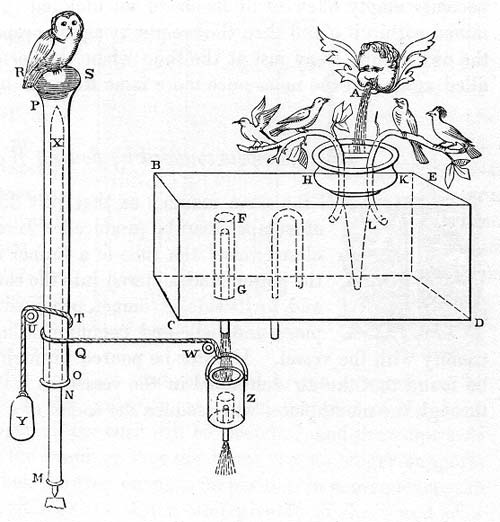
We are now to describe the contrivance by which the owl is enabled to turn herself towards, or away from, the birds as we have said. Let a rod NX turned in a lathe rest on any support M: round this rod let a tube OP be fitted, so as to move freely about it, and having attached to it the kettle-drum top RS, on which the owl is to be securely fixed. Round the tube OP let a chain pass, the two extremities of which, TU, QW, wind off in opposite directions, and are attached, by means of two pulleys, the one, TU, to a weight suspended at Y, and QW to an empty vessel Z, which lies beneath the siphon or inclosed diabetes FG.
It will be found that while the vessel BCDE is being emptied, the liquid being carried into the vessel Z causes the tube OP to revolve, and the owl with it, so as to face the birds: but when BCDE is exhausted, the vessel Z becomes empty likewise by means of an inclosed or bent siphon contained within it; and then the weight Y, again preponderating, causes the owl to turn away just at the time when the vessel BCDE is being filled again and the notes once more issue from the birds.
17. Sounds produced on the opening of a Temple Door.
The sound of a trumpet may be produced on the opening of the doors of a temple. The following is the construction. Behind the door let there be a vessel, ABCD (fig. 17), containing water. In this invert a narrow-necked vessel, shaped like an extinguisher, F, with which, at its lower extremity, let a trumpet, HK, communicate, provided with bell and mouthpiece. Parallel with the tube of the trumpet, and attached to it, let the rod LM run, fastened, at the lower end, to the vessel F, and having at the other extremity a loop, M; through this loop let the beam NX pass, thus supporting the vessel F, at a sufficient height above the water.
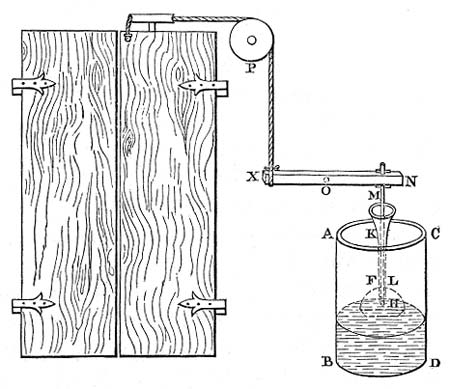
The beam NX must turn on the pivot O, and a chain or cord, attached to the extremity X, be fastened, by means of the pulley, P, to the hinder part of the door. When the door is opened, the cord will be stretched, and draw upwards the extremity X of the beam, so that the beam NX no longer supports the loop M; and when the loop changes its position in consequence, the vessel F will descend into the water, and give forth the sound of a trumpet by the expulsion of the air contained in it through the mouthpiece and bell.
28. An Automaton which drinks at certain times only, on a Liquid being presented to it.
In any place provided with running water make a figure of some animal in bronze or any other material: when a cup is offered to it, the animal shall drink with a loud noise so as to present the appearance of thirst. The following is the construction. AB (fig. 28) is a vessel into which a stream of running water, C, falls. In AB place a bent siphon or inclosed diabetes, DEF, one leg of which must project below the bottom of the vessel. Underneath this let there be an air-tight pedestal, GHKL, also containing a bent siphon, MNX. Below the orifice F place a funnel, OP, the tube of which must descend into the pedestal leaving a passage for the water between its extremity and the bottom.

Let the mouth of the animal be at R, from which a concealed tube, RST, must run along one of the feet, or some other part, into the pedestal. When the vessel AB is filled, the water will overflow and run into the funnel, filling the pedestal GHKL and emptying the vessel AB; in like manner, when the pedestal is full, the water will overflow through the siphon MNX and empty the pedestal; and, as this becomes empty, the air will enter through the mouth R to fill up the void that is left. If, then, we apply a drinking vessel at R, the liquid will be violently attracted and sucked down instead of the air, until the pedestal within has become empty. Then the vessel AB is again filled and emptied, and the same will take place as before. In order that the cup may be applied at the right time, that is, when the water is being drawn off from the pedestal, let something be contrived that will move when struck by water from the discharge through the siphon MNX. When this is seen to move, apply the drinking cup.
29. An Automaton which may be made to drink at any time, on a Liquid being presented to it.
There is another way in which, by the aid of running water, the animal may be made to drink on the revolution of a carved figure of Pan. Let ABCD (fig. 29) be a pedestal, air-tight on every side, and divided into two chambers by a partition. On the surface place the animal, and let the tube EFG pass through its mouth.

Within the pedestal, in the lower chamber, let there be a bent siphon, HKL, the lower leg projecting from the bottom: and let a funnel, MN, pass through the middle of the partition, its tube reaching nearly to the bottom. On the pedestal ABCD place another pedestal, OX, on which the figure of Pan, PR, is to stand, having attached to it the rod S which projects below into the pedestal. To S let the tube TU be fastened, at the end of which is the cup UQ, attached to and communicating with the tube. Let the tube be of such a length that, when the figure PR turns round, the cup UQ will be directly above the funnel MN. On the pedestal, and communicating with it, and directly above the funnel MN, place the cup WY. Let the stream Z, (which must be greater than the discharge through the siphon HKL), flow into WY: the liquid will pass through MN into the lower part of the pedestal, the contained air passing out through EFG: and now the pedestal will continue full as the influx is greater than the discharge. But, when we turn the figure PR round, the cup UQ will intercept the stream Z, which will pass elsewhere through the tube TU, and, as the water no longer flows into the lower chamber of the pedestal, the siphon HKL will empty it, and the air will enter through EFG. Thus, when the cup is applied, the animal will drink as before.
30. An Automaton which will drink any quantity that may be presented to it.
The animal may be made to drink without the aid of running water, or of any thing to move the figure of Pan. Let ABCD (fig. 30) be a pedestal, and E the mouth of the animal, through the breast and hinder foot or tail of which a tube, EFG, is inserted, leading from the mouth E to the interior of the pedestal.
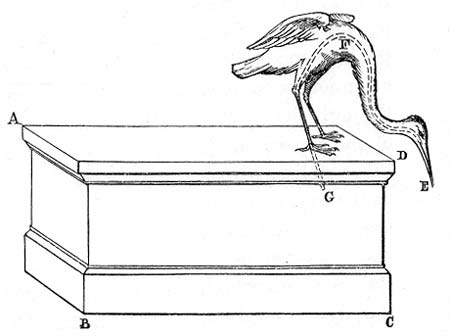
The pedestal having been first firmly fixed, let a hole, E, so fine as to be scarcely discernible, be bored in the tube EFG which passes through the animal, in a line with the extremity G. Now if we fill the siphon EFG with water through some pipe above it, the mouth of which is applied to E, the siphon will continue full since its two orifices lie in the same level. If, therefore, a drinking vessel be brought to the mouth E, and a portion of the mouth immersed in it, it will be found that the leg of the siphon towards G has become the longer, so that it will attract the water, and the water attracted is carried into the pedestal ABCD. In this construction it is not necessary that ABCD should be air-tight.
33. A self-trimming Lamp.
To contrive a self-trimming lamp. Let ABC (fig. 33), be a lamp through the mouth of which is inserted an iron bar, DE, capable of sliding freely about the point E, and let the wick be wound loosely about the bar. Place near a toothed wheel F, moving freely about an axis, its teeth in contact with the iron bar, that, as the wheel revolves, the wick may be pushed on by means of the teeth.
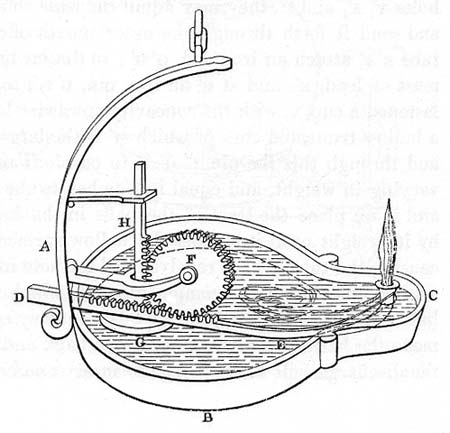
Let the opening for the oil be of considerable width, and when the oil is poured in let a small basin float upon it, G, to which is attached a perpendicular toothed bar, H, the teeth of which fit into the teeth of the wheel. It will be found that, as the oil is consumed, the basin sinks and causes the wheel F to revolve by means of the teeth of the bar, and thus the wick is pushed on.
36. A Satyr pouring Water from a Wine-skin into a full Washing-Basin, without making the contents overflow.
Construct on a pedestal the figure of a satyr holding in his hands a wine-skin: place near a washing-basin, and into this let some liquid be poured until it is full; water shall be made to flow into the basin without running over, until all the water in the skin is exhausted. The following is the construction.
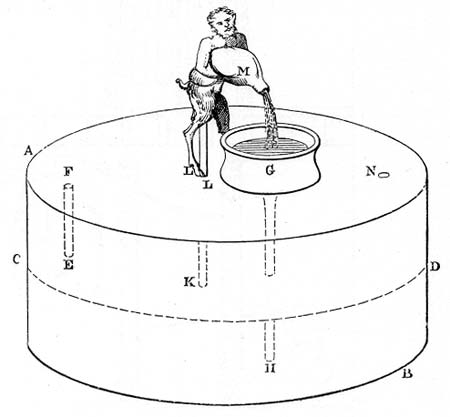
Let AB (fig. 36), be a perfectly airtight pedestal, either cylindrical or octagonal in shape, as may seem more elegant, and divided into two chambers by the partition CD, through which the tube EF fitting closely into the partition, extends upwards nearly to the roof of the pedestal. Through the roof insert the tube GH, projecting slightly above the vessel, and lying exactly under the basin, while, below, it reaches to the bottom except that room must be left for the passage of water: this tube must be soldered into the roof of the pedestal and the partition. Another tube, KLM, must also be inserted through the roof, reaching not quite so low as the partition, soldered into the roof and carrying its stream into the basin, which lies above the tube GH and communicates with it. Now let the vessel AD be filled with water through an orifice N, which must be afterwards closed. If water is poured into the basin, it will pass through the tube GH into the vessel BC; and the air in BC, passing through the tube EF and into the vessel AD, will force the liquid in AD through KLM into the basin; and this being carried again into BC will force out the contained air as before, which, again, will force the water in the vessel AD into the basin: and this will go on until the water in AD is exhausted. The tube KLM must pass through the mouth of the skin and be particularly fine, that the display may last a considerable time.
37. Temple Doors opened by Fire on an Altar.
The construction of a small temple such that, on lighting a fire, the doors shall open spontaneously, and shut again when the fire is extinguished. Let the proposed temple stand on a pedestal, ABCD (fig. 37), on which lies a small altar, ED.
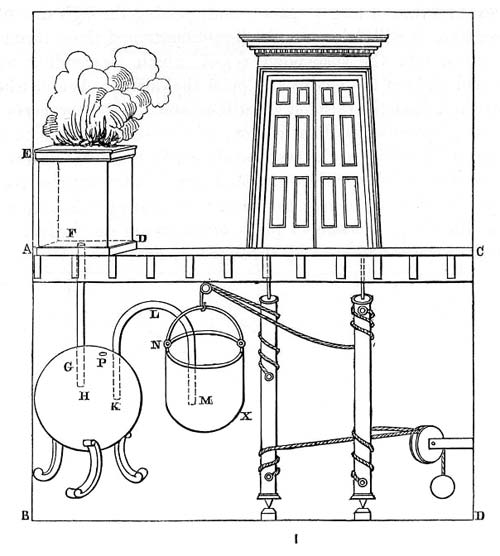
Through the altar insert a tube, FG, of which the mouth F is within the altar and the mouth G is contained in a globe, H, reaching nearly to its centre: the tube must be soldered into the globe, in which a bent siphon, KLM, is placed. Let the hinges of the doors be extended downwards and turn freely on pivots in the base ABCD; and from the hinges let two chains, running into one, be attached, by means of a pulley, to a hollow vessel, NX, which is suspended; while other chains, wound upon the hinges in an opposite direction to the former, and running into one, are attached, by means of a pulley, to a leaden weight, on the descent of which the doors will be shut. Let the outer leg of the siphon KLM lead into the suspended vessel; and through a hole, P, which must be carefully closed afterwards, pour water into the globe enough to fill one half of it. It will be found that, when the fire has grown hot, the air in the altar becoming heated expands into a larger space; and, passing through the tube FG into the globe, it will drive out the liquid contained there through the siphon KLM into the suspended vessel, which, descending with its weight, will tighten the chains and open the doors. Again, when the fire is extinguished, the rarefied air will escape through the pores in the side of the globe, and the bent siphon, (the extremity of which will be immersed in the water in the suspended vessel) will draw up the liquid in the vessel in order to fill up the void left by the particles removed. When the vessel is lightened the weight suspended will preponderate and shut the doors. Some in place of water use quicksilver, as it is heavier than water and is easily disunited by fire.
40. On an Apple being lifted, Hercules shoots a Dragon which then hisses.
On a pedestal is placed a small tree round which a serpent or dragon is coiled; a figure of Hercules stands near shooting from a bow, and an apple lies upon the pedestal: if any one raises, with the hand, the apple a little from the pedestal, the Hercules shall discharge his arrow at the serpent and the serpent hiss. Let AB (fig. 40) be the proposed pedestal, air-tight and divided by a partition, CD. Fixed in the partition is a hollow truncated cone, EF, the lesser circle of which, F, is open and approaches to the bottom of the pedestal, leaving a sufficient interval for the passage of water. To this cone must be tightly fitted another cone H, attached by means of a chain through a hole in the surface, to the apple K, which lies on the pedestal.
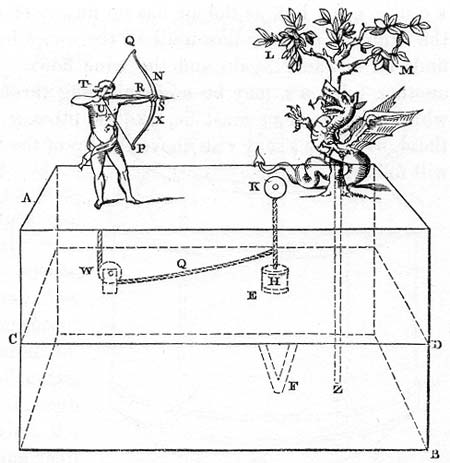
Let the Hercules hold a small bow of horn, the string of which is stretched, and at the proper distance from the hand. In the right hand, and directed towards the serpent, let there be a hand in every respect similar to the visible hand, but smaller, and holding the trigger. From the extremity of the trigger let a chain, or cord, proceed through the pedestal and be attached to a pulley, which is placed above the partition, and again to the chain which is connected with the cone and apple.
Now we must draw the bow, and placing the trigger beneath the hand, close it so that the cord is stretched and draws the apple tightly downwards: the cord must run inside the Hercules and through the body and hand. From the partition let a small tube, one of those which are used to whistle, extend above the pedestal and pass under the tree or along its trunk. Then fill the vessel AD with water. Let LM be the tree, NX the bow, SP the string RS the hand that grasps the bow, TU the trigger, QW the cord, W the pulley round which the cord runs, and YZ the whistling pipe. Now if some one raise the apple K, he will at the same time raise the cone H, tighten the cord QW, and draw back the hand, so that the arrow is discharged: and the water in AD, being carried into BC, will drive out the air contained in BC through the pipe, and produce the hissing sound. When the apple is replaced, the cone H fitting again into the other, will stop the stream of water so that no sound is produced. We must now re-arrange the arrow and leave it. If the vessel BC is full, it can be emptied again by means of a spout with a key: AD must be filled as before.
43. Notes from a Bird produced at intervals by an intermittent Stream of Water.
THE notes of birds are produced at intervals as follows. Take an air-tight vessel (fig. 43), through which a funnel is inserted, the tube being far enough from the bottom of the vessel to allow of the passage of water.

Above the funnel is placed a hollow vessel, turning on pivots, and having a weight below, into which water is continually carried. So long as the vessel on the pivots is empty it will be found to remain upright, for a weight is attached to its bottom; but, when the vessel is filled the water is overturned into the air-tight vessel, and the air contained in the vessel being driven out through a small pipe will produce the sound. The vessel is emptied of water by means of a bent siphon, and, while it is being emptied, the vessel on pivots is again filled and overturned. It will be requisite that the stream of water should not fall into the centre of the vessel on pivots, that when filled it may be inverted speedily.
44. Notes produced from several Birds in succession, by a Stream of Water.
SOUNDS are produced at intervals in another way as follows. A vessel is taken (fig. 44), provided with several transverse partitions.
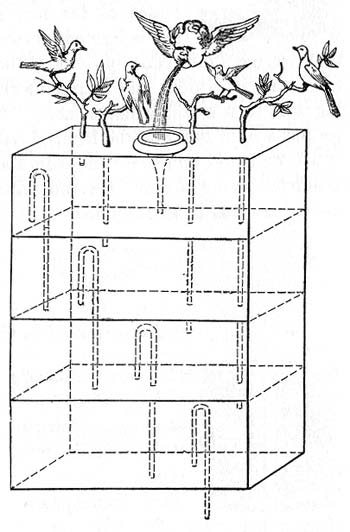
In the chambers are placed siphons conducting into the chambers beneath, the streams through them being unequal. In the lower compartment is placed the pipe which produces the sound, and the stream of water falls into the upper compartment. It will be found that when the upper chamber is filled, the water passes through the siphon placed there into the chamber below, until it has arrived at the lowest, and the vessel being air-tight, the air in this chamber is driven out through the pipe and produces the sound.
50. The Steam-Engine.
PLACE a cauldron over a fire: a ball shall revolve on a pivot. A fire is lighted under a cauldron, AB, (fig. 50), containing water, and covered at the mouth by the lid CD; with this the bent tube EFG communicates, the extremity of the tube being fitted into a hollow ball, HK.
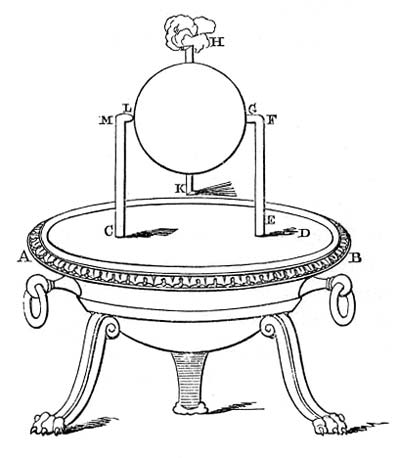
Opposite to the extremity G place a pivot, LM, resting on the lid CD; and let the ball contain two bent pipes, communicating with it at the opposite extremities of a diameter, and bent in opposite directions, the bends being at right angles and across the lines FG, LM. As the cauldron gets hot it will be found that the steam, entering the ball through EFG, passes out through the bent tubes towards the lid, and causes the ball to revolve, as in the case of the dancing figures.
54. Water driven from the Mouth of a Wine-skin in the Hands of a Satyr, by means of compressed Air.
IF wind is blown through the mouth of certain figures, they spout up water through some other place. For example, if a satyr holds a wine-skin water shall be spouted up through the skin.
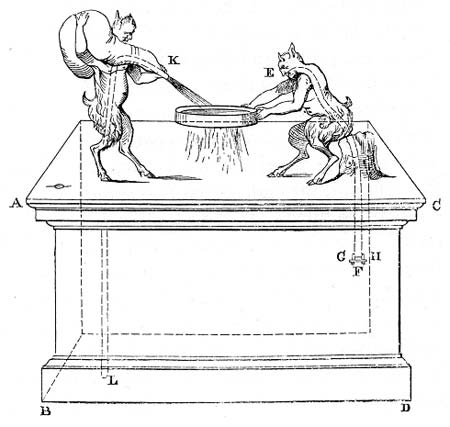
ABCD (fig. 54), is an air-tight pedestal on which the figure is placed through the mouth of the figure a tube, EF is inserted, communicating with the pedestal, and having underneath it a small plate, GH, which closes the aperture F of the tube, and is supported by pins to which buttons are attached, that the plate may not fall off. Another tube, KL, is passed through the pedestal, of which the extremity, K, must be contiguous to the point at which the water-jet is to be, and the extremity, L, reach to the bottom of the pedestal, leaving only a passage for the water. At the extremity K there must be a valve or tap by which the aperture K, which is very small, may be shut. Now if we pour any quantity of water into the pedestal through a hole, which we must afterwards stop, and, having closed the aperture K, blow in air through the tube EF, the air blown in will thrust aside the plate and descend into the pedestal: and, if this is done several times, the air in the pedestal will be compressed and close the plate. Let the valve or tap be opened, and after a short time the compressed air will drive the liquid in the pedestal violently out through the aperture K, until all the liquid is spouted up, and the air is brought back to its natural state, that is, in which it is no longer subject to compression.
60. Libations poured on an Altar, and a Serpent made to hiss, by the Action of Fire.
WHEN a fire is kindled on an altar, figures placed near shall offer libations, and a serpent hiss. Let there be a hollow pedestal, AB (fig. 60), on which is an altar, C, containing within it a tube, DE, which descends from the hearth of the altar to the pedestal, and then branches off into three tubes, EF leading to the mouth of the serpent; EGH to a wine vessel KL, (the bottom of which must be higher than the figure M,) and fastened to the lid of KL cross-bar fashion; while the other tube ENX, in like manner, extends into another wine vessel OP, also terminating in a cross-head.
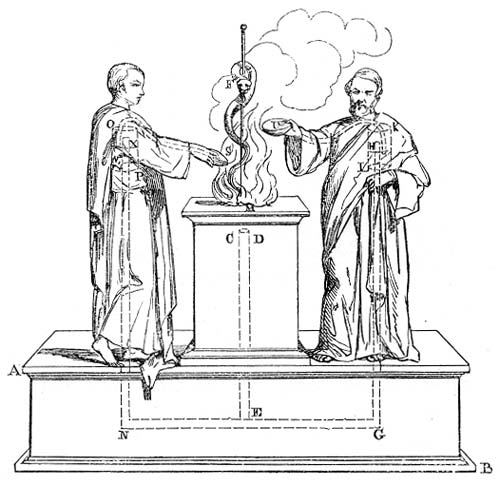
Both these tubes must be soldered into the bottoms of the vessels, and in each wine vessel there must be a bent siphon, RS, and TU, one extremity of each being immersed in the wine, and the other, (from which extend the hands of the figures which are to pour the libations,) passing, air-tight, through the sides of the wine vessels. When the fire is about to be kindled, pour first a little water into the tubes, that they may not be burst by the dry heat, and close up everything that no air may pass through. The hot air, becoming mixed with the water, will ascend along the tubes to the cross-heads, and through them it will exert pressure on the wine, and carry it to the bent siphons RS and TU. The wine flowing through the hands of the figures produces a libation as long as a fire is burning on the altar. The other tube, conveying the hot air to the mouth of the serpent, will cause the serpent to hiss.
63. A Water-Clock, made to govern the quantities of Liquid flowing from a Vessel.
A VESSEL containing wine, and provided with an open spout, stands upon a pedestal: it is required by shifting a weight to cause the spout to pour forth a given quantity,--sometimes, for instance, a half cotyle (1/4 pint), sometimes a cotyle (1/2 pint), and, in short, whatever quantity we please. AB (fig. 63), is the vessel into which wine is to be poured: near the bottom is a spout, D: the neck is closed by the partition EF, and through EF is inserted a tube, GH, reaching nearly to the bottom of the vessel, but so as to allow of the passage of water. KLMN is the pedestal on which the vessel stands, and OX another tube reaching within a little of the partition and extending into the pedestal, in which water is placed so as to cover the orifice O, of the tube.
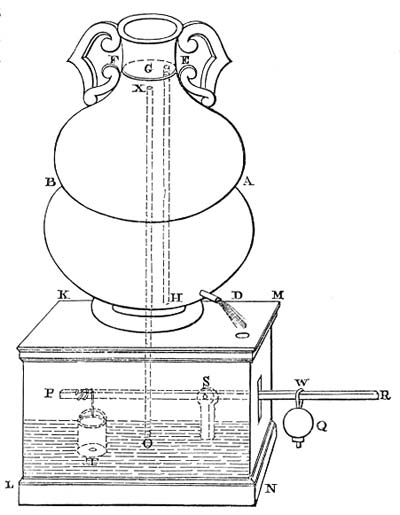
Fix a rod, PR, one half within, and the other without, the pedestal, moving like the beam of a lever about the point S; and from the extremity P of the rod suspend a water-clock, T, having a hole in the bottom. The spout D having been first closed, the vessel should be filled through the tube GH before water is poured into the pedestal, that the air may escape through the tube XO: then pour water into the pedestal, through a hole, until the orifice O is closed, and set the spout D free. It is evident that the wine will not flow, as there is no opening through which air can be introduced: but if we depress the extremity R of the rod, a portion of the water-clock will be raised from the water, and, the vent O being uncovered, the spout D will run until the water suspended in the water-clock has flowed back and closed the vent O. If, when the water-clock is filled again, we depress the extremity N still further, the liquid suspended in the water-clock will take a longer time to flow out, and there will be a longer discharge from D: and if the water-clock be entirely raised above the water, the discharge will last considerably longer.
To avoid the necessity of depressing the extremity R of the rod with the hand, take a weight Q, sliding along the outer portion of the rod, RW, and able, if placed at R, to lift the whole water-clock; if at a distance from R, some smaller portion of it. Then, having obtained by trial the quantities which we wish to flow from D, we must make notches in the rod RW and register the quantities; so that, when we wish a given quantity to flow out, we have only to bring the weight to the corresponding notch and leave the discharge to take place.
68. A Shrine over which a Bird may be made to revolve and sing by Worshippers turning a Wheel.
THE construction of a shrine provided with a revolving wheel of bronze, termed a purifier, which worshippers are accustomed to turn round as they enter. Let it be required that, if the wheel is turned, the note of the black-cap shall be produced, and the bird, standing on the top of the shrine, turn round as well; while, if the wheel is turned [in the opposite direction], the black-cap neither sings nor revolves. Let ABCD (fig. 68), be the shrine and EF an axis extending across it, capable of revolving freely, to which the wheel HK, which is to be turned round, is attached. Let two other wheels be attached to the axis, in the interior of the shrine, L and M, of which L has a pulley, and M is a wheel with rays.

Round the pulley a cord is wound, from the extremity of which is suspended a vessel N, shaped like a conical oven, and provided with a tube XO, terminating in a small pipe which produces the note of a black-cap: under the conical vessel N must be placed a vessel of water. From the top of the shrine let fall a small axis ST capable of revolving freely: at the extremity S let a black-cap be placed, and at T a wheel with rays, the rays of which are implicated with, or take into, the rays of the wheel M. It will be found that, when the wheel HK is made to revolve, the cord is wound round the pulley and raises the conical vessel N; but, if the wheel is let go, N descends by its own weight into the water and produces the sound by the expulsion of the air. The black-cap turns round at the same time owing to the revolution of the wheels.
70. Figures made to dance by Fire on an Altar.
WHEN a fire is kindled on an altar, figures shall be seen to dance: for the altars must be transparent, either of glass or horn. Through the hearth of the altar (fig. 70), a tube is let down turning on a pivot towards the base of the altar, and, above, on a small pipe which is attached to the hearth.
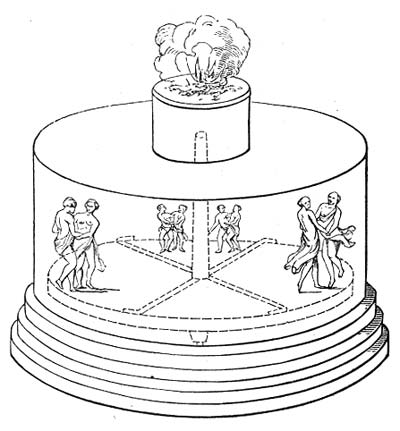
Communicating with, and attached to, this tube are smaller tubes lying at right angles to each other, and bent at the extremities in opposite directions. A wheel or platform on which the dancing figures stand, is also fastened to the tube. When the sacrifice is kindled, the air, growing hot, will pass through the pipe into the tube, and be forced out of this into the smaller tubes; when, meeting with resistance from the sides of the altar, it will cause the tube and the dancing figures to revolve.

|